The cheerful nature of people of Ladakh is infectious and easily rubs on to people visiting the region. It is perhaps one of the important factors besides magnificent landscapes and expansive lakes that attracts visitors from across the world to Ladakh. Here are some images of people of Ladakh.
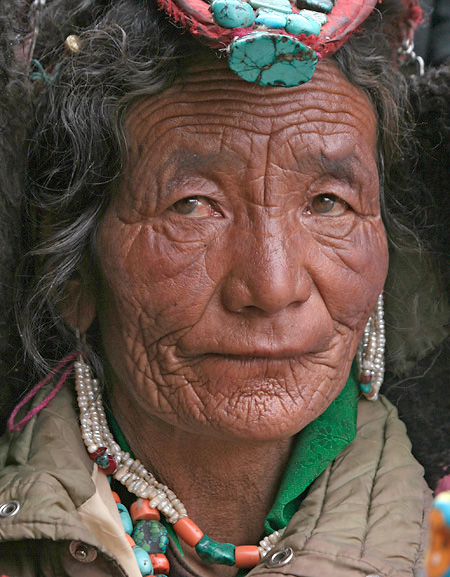
A lady at looks on as the annual Gustor Festival is in progress at Korzok Village on the banks of Tso Moriri Lake. The monastery festival is an opportunity for nomadic changspa people to get together and meet. Women adorn their turquoise jewellery and come dressed at their traditional best. People of all ages gather at the monastery, greet their friend and relative and celebrate the two-day festival that has a mix of tradition and revelry.

A changspa woman with her turquoise-embedded headgear at the annual Korzok Gustor Festival.
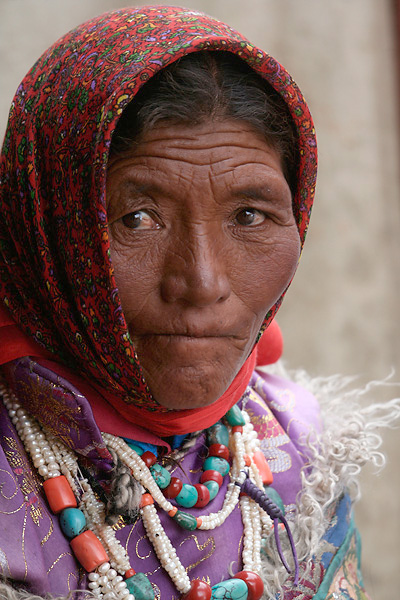
A changspa woman with her turqoise embedded jewellery at the annual Korzok Gustor Festival.
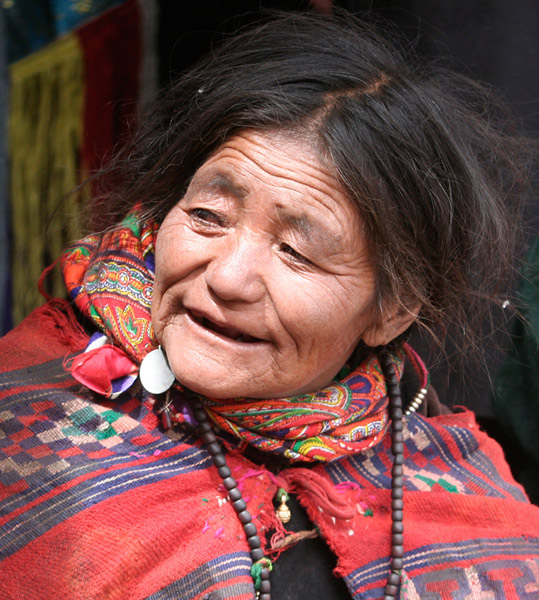
A changspa woman at Korzok Gustor Festival
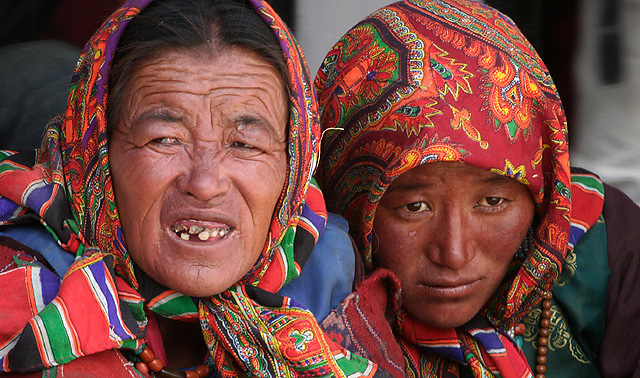
Changspa women at Korzok Gustor Festival
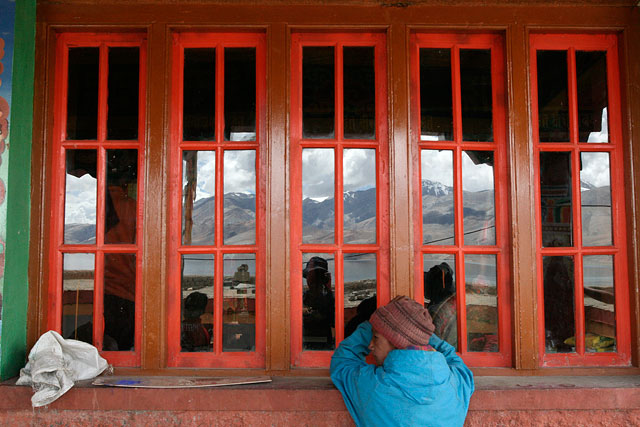
A boy peeks through the window of the prayer hall at Korzok Monastery to look at the monks getting prepared for the festivals in the room, while the mountains and Tso Moriri Lake reflect in the window.

Smiling children watching dancing monks at Korzok Gustor Festival
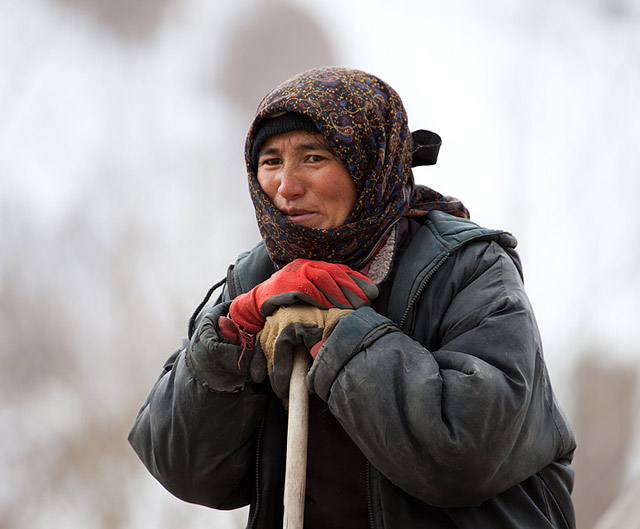
The remote Zasnkar Region gets cut off from rest of the world in the winter months, when the roads are buried in deep snow and the temperature dips 20 degrees below zero. But life must go on – the sheep have to fed, the stove must keep burning and the children must go to school. Children are going to modern schools in Zanskar only in the last few decades.
In winters, people of Zanskar rarely see new faces, except for a few adventurers who make the long walk on the frozen Zanskar River and stay for a few days in the villages before heading back. Such visitors incite the curiosity of the villagers who are always happy to begin a conversation and perhaps invite them over for a cup of tea.
This woman at Zangla Village takes a moment to talk to us at the end of day that is usually filled with lot of work even in the frigid winter months.
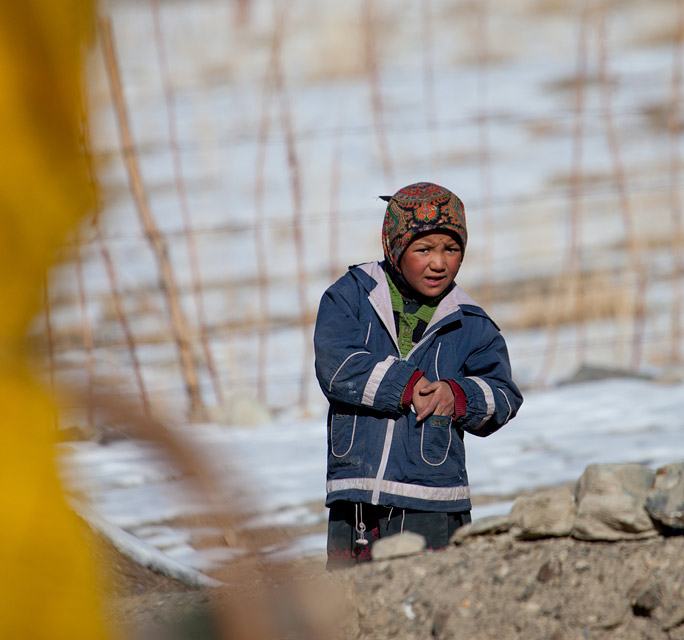
A girl pauses to speak to her mother before heading out to the school, where she will be spending her first half of the day.
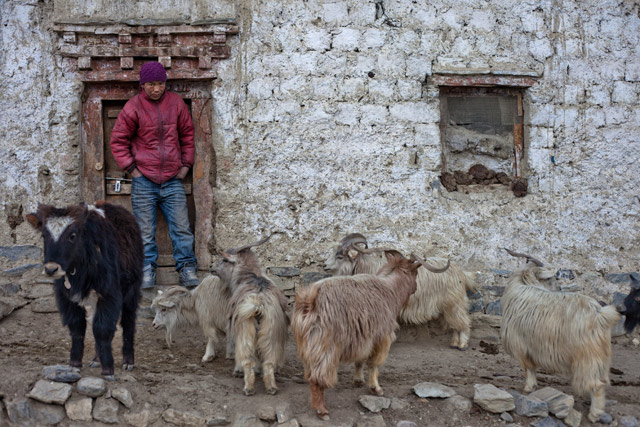
A young man has a short conversation with us before leading his sheep into a covered stable in the evening.
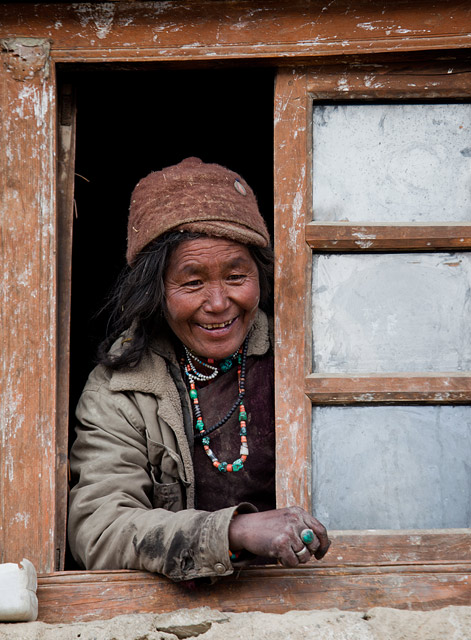
A lady is smiles at us looking through the window as we stop by to talk with her young lad taking care of his sheep nearby.
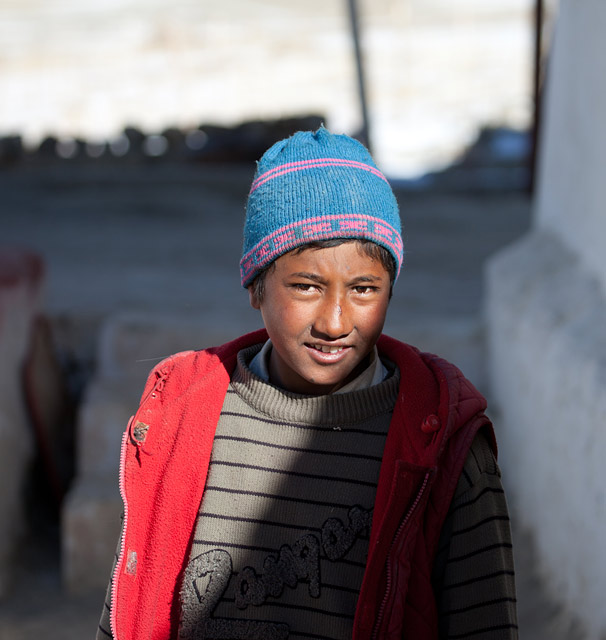
A shy boy at the house where we were staying in Zangla Village poses for the camera.
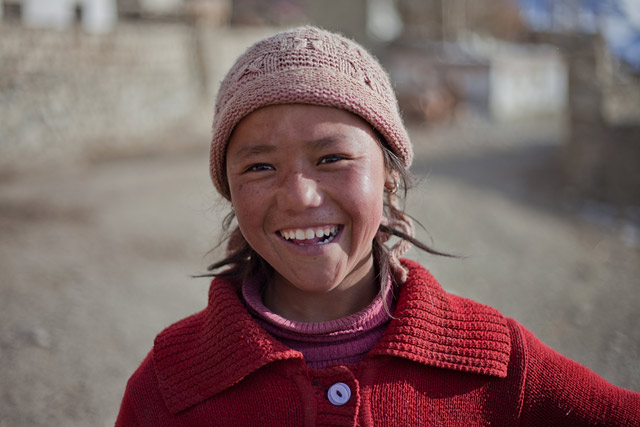
A girl smiles brightly as she starts a conversation and asks me to take her picture.
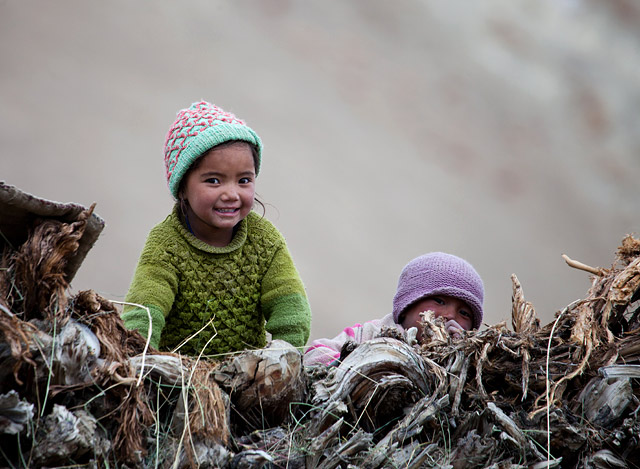
Children are happy to see new faces at their village on a cold winter evening. This little girl sang loudly to draw our attention, as her shy brother looks on hiding behind a stack of wood and hay.
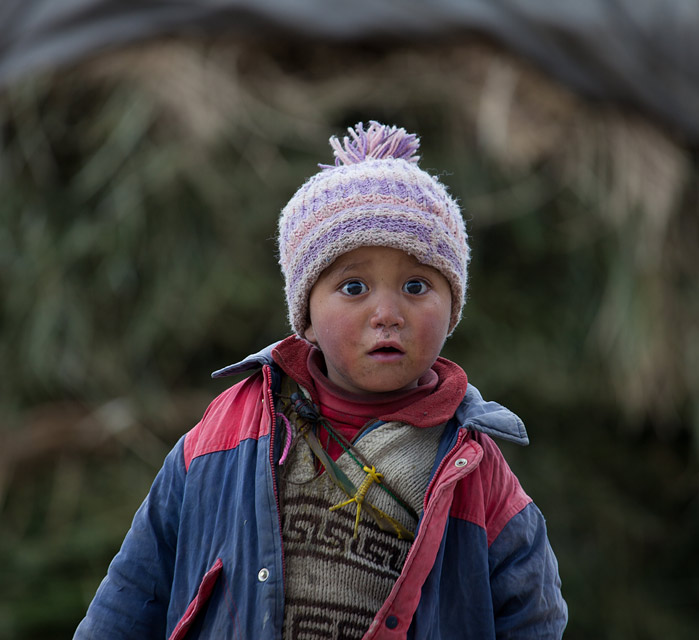
A curious young lad at Zangla Village, Zanskar.
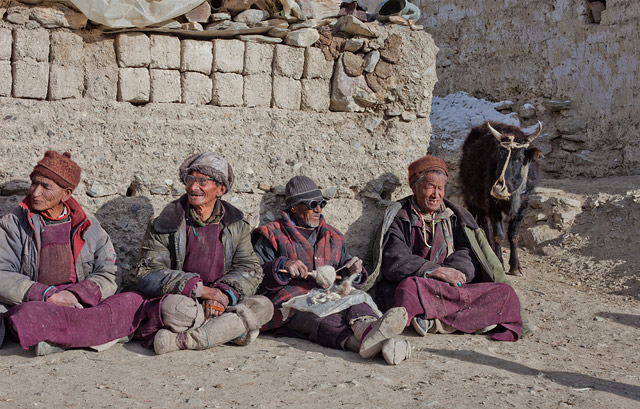
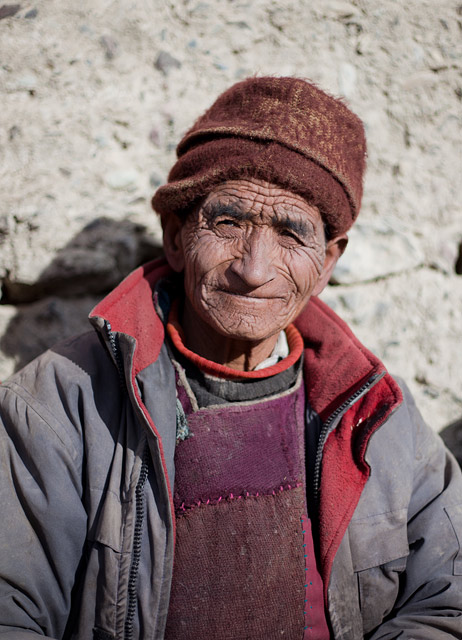
Traditionally, people gave up their ownership of land and home to their children after crossing certain age, built a khangbu—small house of their own—and retired to a life of simple living. I have never really seen a Khangbu anywhere in Ladakh. Perhaps this is a fading tradition, as I have seen houses where elders still share the family house.
In Zanskar’s Zangla Village, we saw this bunch of old men and women sunning in the evening. Some were busy knitting while everyone made some casual conversation, sometimes between themselves and sometimes with us.
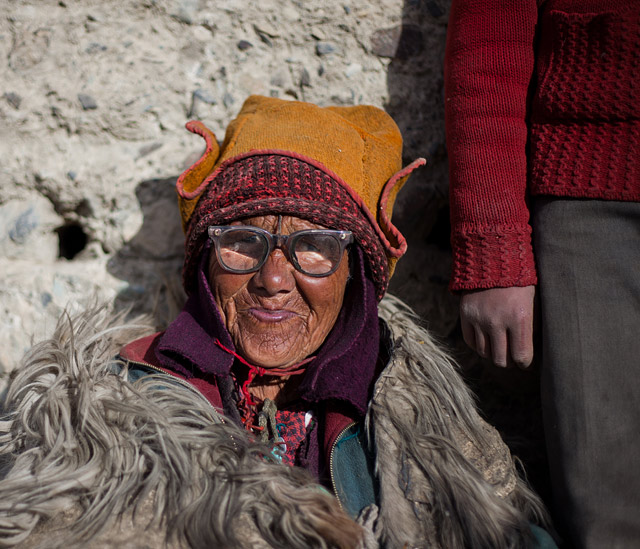
An elderly woman wearing sheepskin over traditional goncha smiles at us, while a young girl wearing a woolen sweater stands next to her.
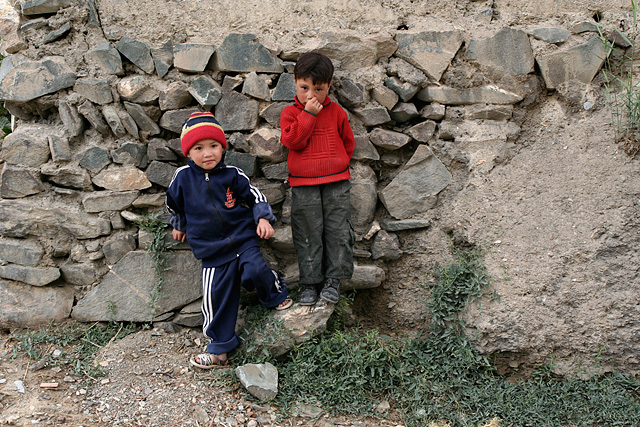
These children, who were playing quietly just outside their village at Lamayuru, pause briefly to look at the visitors.
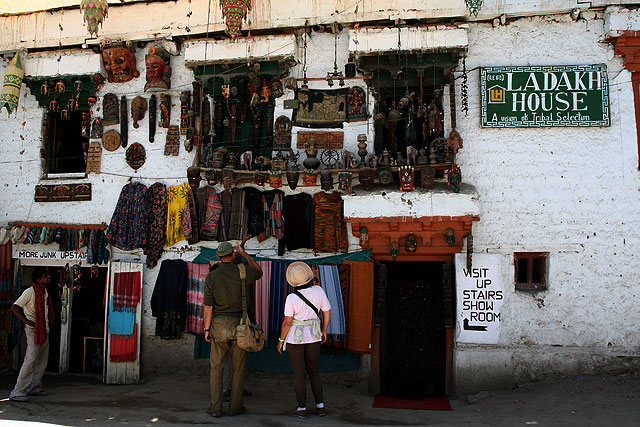
It is perhaps important to include tourists in the population of Ladakh, especially in the short summers when their numbers swell and perhaps exceeds the residents by manifolds. Leh, once a trading center and a town where several trading paths intersected and goods exchanged, now sees an influx of large number of visitors in the summer months when the weather is at its best. A good percentage of Ladakh’s population now depends on tourism income. This is also a time when there is a temporary immigration of a workforce that caters to tourists, who go back in the winter months when there are hardly any outsiders in the town.
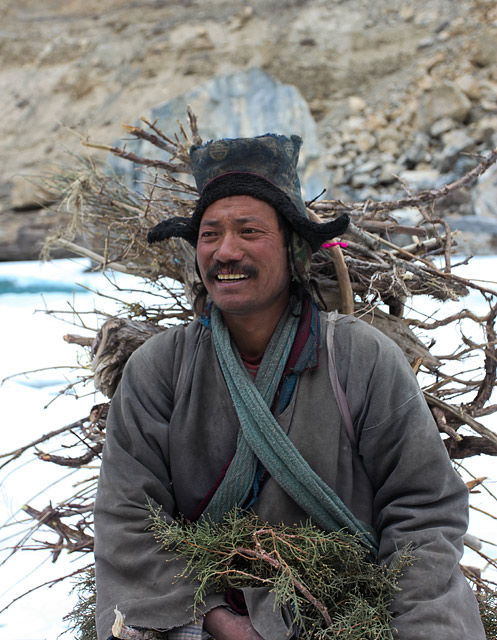
One of the great characteristics of Ladakhis is their abilities and physical strength to cope up with harsh weather and subject themselves to hard work. On a difficult expedition of walking on the frozen Zanskar River, Zanskari porters play the role of heroes who go to great extent to keep their visitors comfortable. They carry the luggages, cook and sometimes even carry trekkers on their shoulders when there is a need to step into the frigid waters. After a long day’s walk of pulling the load on their sledges, a porter still has the time for a big smile, and energy to collect a big load of wood by scouring the mountains.
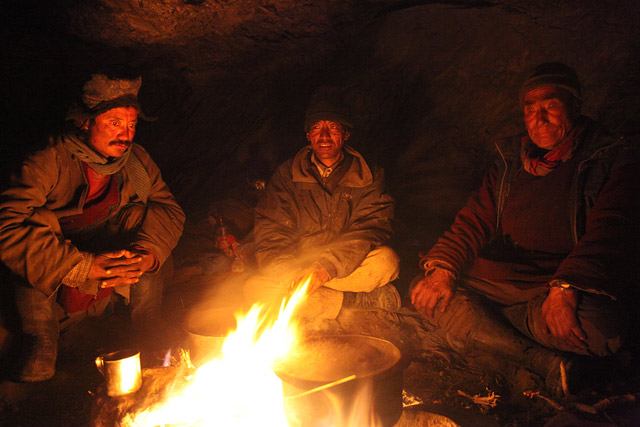
Porters warm up in a cave and cook their food as they get ready for a cold night with temperature reaching 20 degrees below zero in Zanskar.
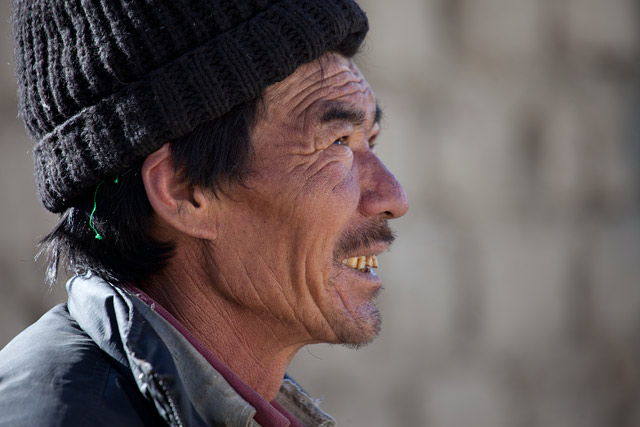
A porter who accompanied our group on the long expedition to Zanskar from Leh, walking on the frozen Zanskar River.
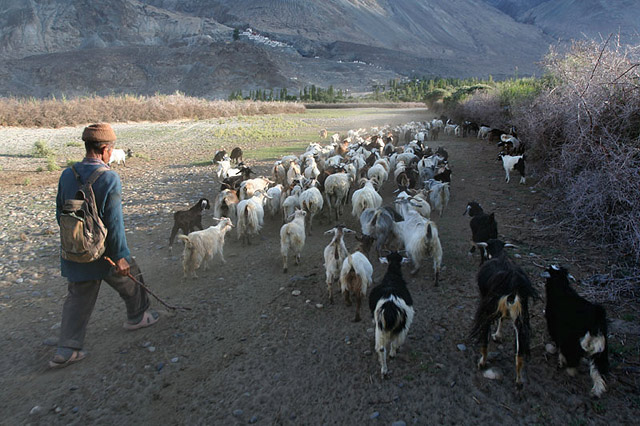
Sheep and Pashmeena Goats are an important part of Ladakh’s rural economy. While Barley fields take care of feeding the villages, Pashmeena Wool brings the much needed cash to buy everything else needed for the household. A shepherd is herding the goats back home after a day of taking them to graze in the wilderness of Nubra Valley.
Also read: my essays on the people of Ladakh.
Also see part I and part II
As I walked through cedar groves, grassy slopes and small lanes with cafes selling cappucchinos in McLeodGanj, I was distinctly aware of a few things I was going to miss during my visit. I so wished to see and listen to His Holiness, who was away travelling on the days I was in the town. I also wished to go higher into the mountains, visiting the snowline and go beyond with Gaddi Shepherds, exploring the highland pastures in Dhauladhars. All of them will have to wait for another visit – my stay at McLeodGanj this time was going to be a short one, allowing me just some glimpses of its beauty.
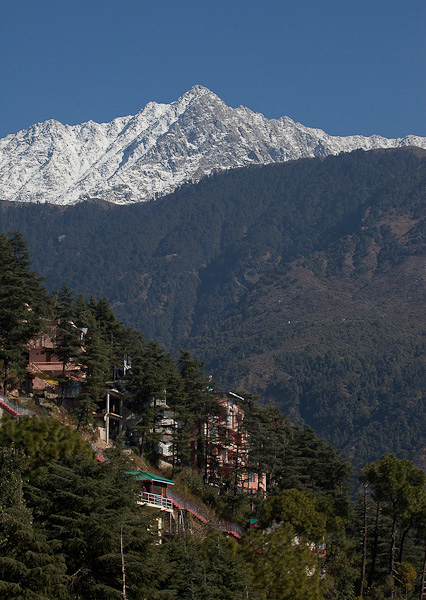
And beautiful were the town and its surroundings. I wandered the streets watching smiling monks in ochre robes walk by, chanting slowly as they turned their prayer wheels or counted rosaries. The shops along the narrow lanes sold prayer flags, thangkas, small prayer wheels, cham-dance -masks and everything that can be sold to devout Tibetans as well as the tourist looking to carry home some memories. Modern-looking restaurants frequented these roads, selling garlic bread, lemon tart and apple cakes. The option in cuisines were wide enough to take you on a world-tour-in-a-day, starting from Indian and offering Mediterranean, Italian, Japanese, Mexican and anything else you can imagine.
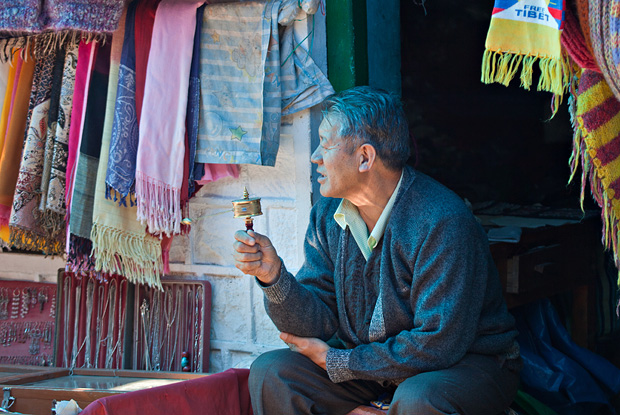
In the middle of these was a bright gilded shrine that was visible from most parts of the small Temple Road. An array of prayer wheels dotted the walls of this shrine, occasionally visited by elderly men who walked slowly as they turned the wheel. I walked behind them, turned a large number wheels in on stroke and watched the brightly painted sacred letters – om-mani-padmeham go round and round on one wheel after the other.
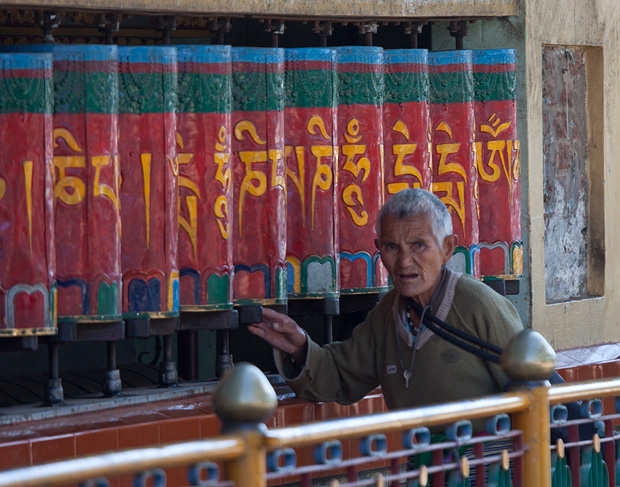
I walked out from the town downhill, in the direction of Forsyth Ganj along the main road connecting McLeodGanj with rest of the world. It is a main-road for name’s sake but was quiet and vehicle free, ideal for long walks but convenient enough to catch the next bus when the legs give away. I was looking forward to visit ‘St.John in the Wilderness’ – a quaint church introduced to me by Shalabh. To repeat his words on the history of the church: “First built in 1852 in neo-Gothic architecture and repaired multiple times subsequently, the cathedral’s graveyard is also the final resting place of Lord Elgin, viceroy of India from 1862-1863. The church is known for its Lady Elgin donated Belgian stained glass windows. Also of note is the church bell, made by Mears and Stainbank Founders, London, installed in July 1915. This church bell replaced the bell tower destroyed in the 1905 Kangra earthquake. Set in a thick, old Deodar jungle with its collection of old graves, the church yard seems to take you into a bygone era.”
The Church is a small hall with its own history, whose location in a cedar grove is as charming as the church itself. A small grave behind the church has plenty of history buried under it, but it was such a pleasure being in this forest and wandering freely as the legs decide, I allowed history to take backseat.
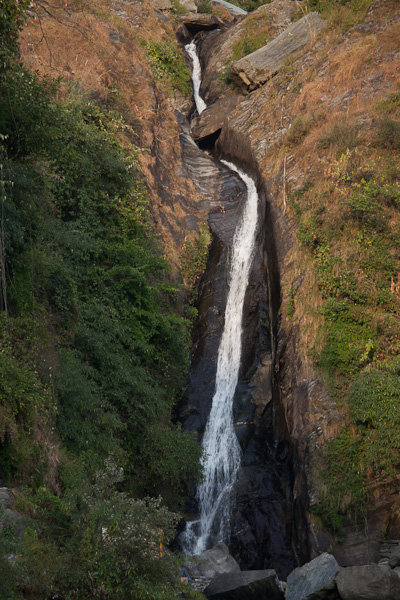
That evening, my last day in Ganj, I made a quick visit to Bhagsu Waterfall before rushing to catch my bus. The walk to the falls is through a small alley past the ancient Bhagsu Temple, passing through shops selling merchandise of worship. Going past these settlements, McLeodGanj offers more possibilities as the bridle path to the fall opens up to the vista of beautiful hills and small paths leading into the heart of the mountains. I thought of walking farther and farther, past the cleverly named “No Name Cafe” and into the cedar trees beyond to explore the higher regions in the Dhauladhar. The Ganj needs another, longer visit.
End of series.
See part I and part III
My long walks lead me several times to the abode of Dalai Lama in search of the charm that attracts thousands of people to this small town in the Himalayas. A narrow long passage and empty hallways greeted me to a prayer hall colourfully decorated like every Tibetan Monastery is. The open spaces around the prayer hall, perhaps teeming with people on some days to listen to the lectures of His Holiness, now remained silent but for the laughter of a few tourists and murmuring chants of monks passing by.
His Holiness himself was away and travelling as he normally is for most days of the year. For a moment the open surroundings of the temple appeared to have little of interest in the absence of Dalai Lama. The prayer halls were empty and I did not feel a sense of belonging that I hoped to experience in his abode. I sauntered aimlessly from one end of the temple to other,watching the few tourists who made a quick tour of the temple and the genial monks with rosaries humming their chants. A small number of devout Tibetans prostrated repeatedly in front of the prayer hall, bowing down and coming up again and again, sometime joined by western faces coming under Richard-Gere-like influence from Buddhist preachings. Many of the prostrating Tibetans appeared calm and contented, offering unrequited devotion to their spiritual leader and to the forces of the other world. But a few faces gave away a hint of anxiety and pain, perhaps towards their kins suffering from suppression in their homeland.
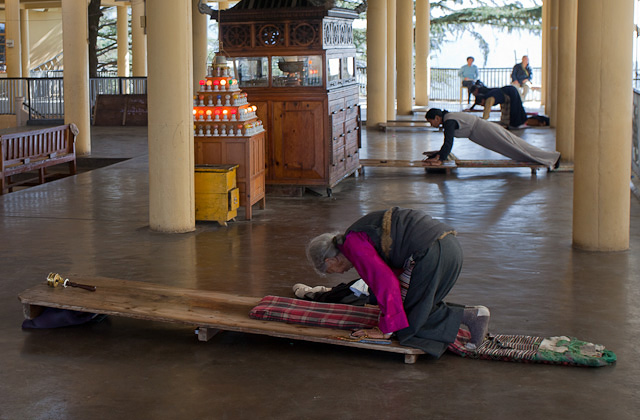
A small museum, curated by men who escaped from Tibet to India, tells the story and state of Tibetan People in their homeland today. The displays at the museum show images of Tibetan warriors trying to face People’s Liberation Army, images of Chinese Soldiers in the plateau, the stories of Tibetans escaping through high passes buried in snow, destroyed monasteries and forced education that children now go through.
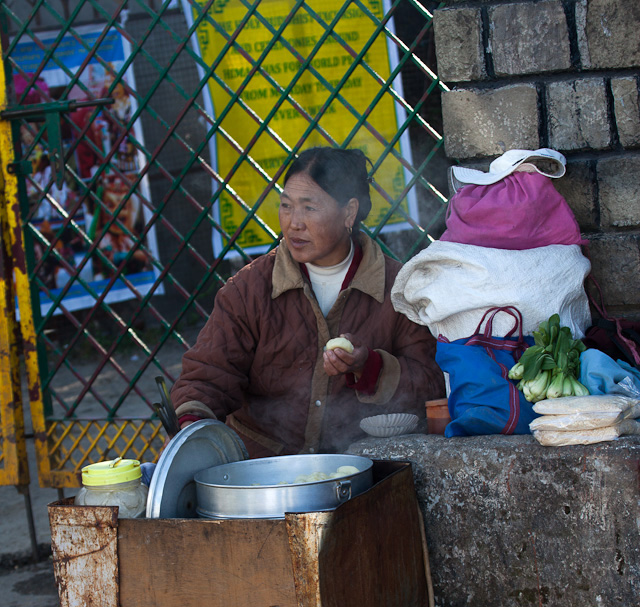
Hot momos anyone?
Walking past the Dalai Lama Temple, stopping briefly to buy freshly baked potato momos from Tibetan Women who sold it on the street, I dragged my feet downhill to discover a circumambulation path around the temple. A small paved path went through a cedar grove behind the temple, taken by a few monks and worldly Tibetan but rarely any tourists. The quiet, green path through the slopes was decorated with brightly couloured prayer flags and painted mani-stones. A few minutes of walking, I stumbled into two monks carefully carving the stones with the sacred mantra – ‘Om Mani Padmeham,’ working the chisel slowly on the rocks and stopping occasionally for a conversation with passing monks.
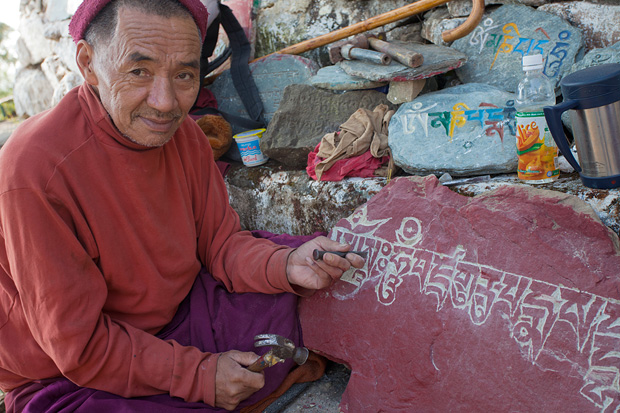
Further along the path was a small place of worship next to a home for Tibetan senior citizens. In front of this were a few stupas placed haphazardly along the slopes, surrounded by a riot of colourful prayer flags that added a cheerfulness touch to the circumambulation path.
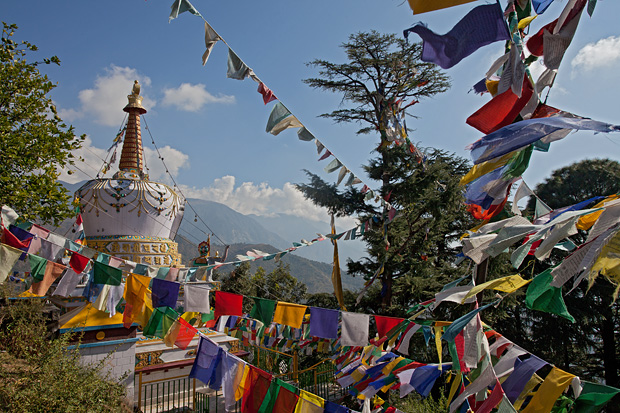
Beyond this was a thick vegetation where I spent nearly an hour looking at several birds which I had never seen before and never known their names before arriving at the gates of the temple again.































